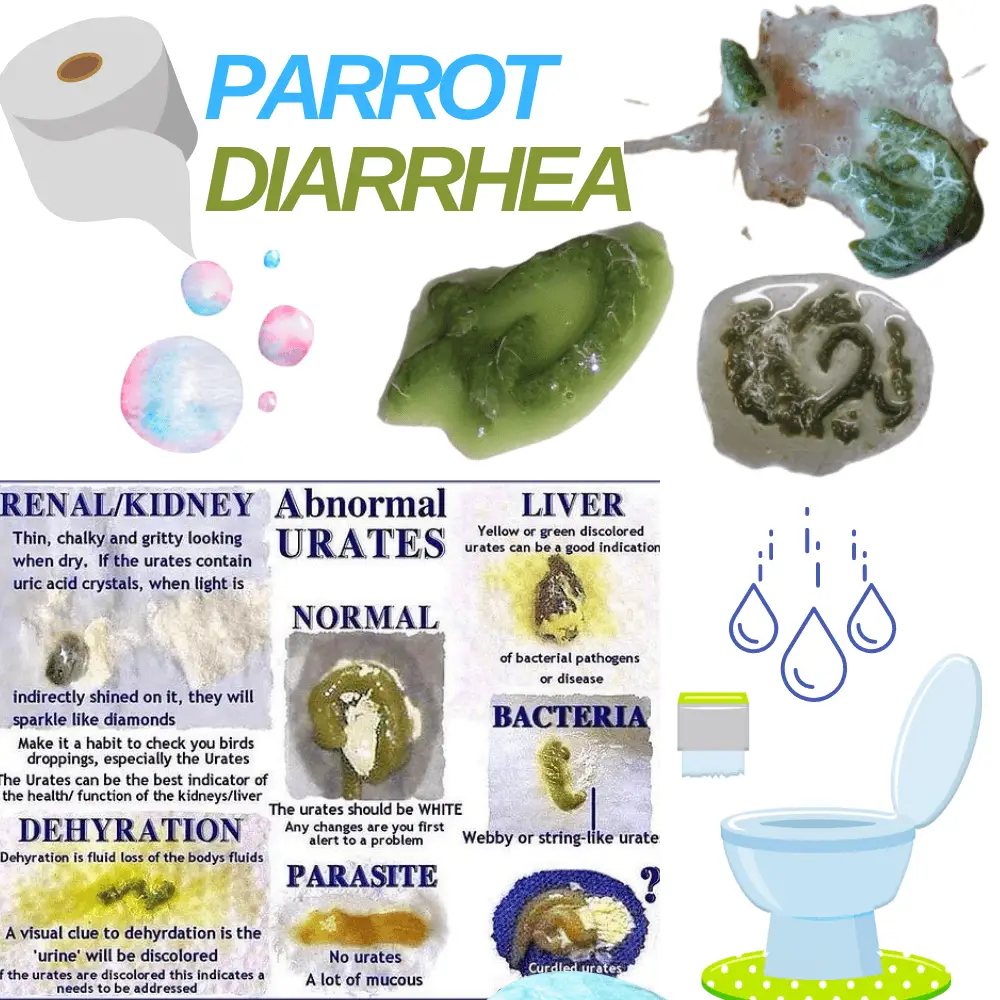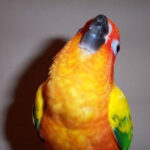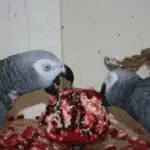
Parrot Diarrhea: One drop, two drops, three drops. That should be enough, Solange thought to herself. This is what is written on the bottle. Her parrot has diarrhea and she is about to give him the medicine she got from the pet store.
Pierrot, his Amazon, however, does not seem to want to be cooperative. Of the three drops deposited on his food, it is very difficult to say what he really swallowed. His vigorous pecks in the bowl of seeds seem to have scattered the magic potion to the four winds.
Despite treatment, the parrot’s cage bottom persists in quickly becoming soggy. An unpleasant odor emanates from it. Solange finally makes an appointment with her vet. She explains to him that for a little over a month, her bird has had diarrhea.
His stools are so liquid that when he defecates, a jet of water is projected. She has also noticed that he has been drinking more lately. According to her, Pierrot must not be so sick; his appetite has never been so good. One could even say that it is more and more voracious.
Pierrot’s physical examination shows that he has lost much weight since his last visit, even if nothing appears from the outside. Observing the bottom of his cage reveals some clues. In fact, the bird does not have diarrhea, but rather produces a significant amount of urine.

Parakeet poop chart
The normal saddle of a parrot consists of three parts
- A solid and colored part (brown or greenish depending on the diet) represents the saddle itself. In case of diarrhea, this portion is no longer in shape.
- A solid ( creamy white ) part of chalky consistency that comes from the kidneys. They are urates.
- A liquid part is like water. It is only present when the body eliminates excess fluid ( if the bird eats a lot of foods rich in water or if it is sick ).
In Pierrot’s case, it is wrong to claim that he has diarrhea. The colored part of his stool is well-formed. It is, therefore, unnecessary to treat it for this problem. An impressive amount of liquid, however, wets the bottom paper of the cage. We must find the cause of this overproduction of urine.
A small amount of urine is taken along with a blood sample. Their analyzes do not give reassuring results. A large amount of glucose is present in the urine and in the blood sugar level (blood sugar) is very high. Pierrot suffers from diabetes. This is not reassuring because this disease is still poorly understood in birds. Blood sugar control is a complex process modulated by hormones produced by the pancreas.
The two main ones are insulin and glucagon. Insulin works to allow blood sugar to enter cells when blood sugar is too high. Glucagon for its part allows the sugar stored in the body to be released in order to normalize too low blood sugar.
In humans, diabetes involves a problem with insulin management (either not having enough of it or it is no longer working as it should). In grain-eating birds, it is not insulin that is primarily responsible for controlling blood sugar, but glucagon. In the diabetic parrot, it seems that glucagon increases blood sugar abnormally.
Parrot Diarrhea

In order to regulate Pierrot’s blood sugar levels, his diet was first of all changed. All sweet fruits have been removed as well as all other foods containing sugar. Blood tests showed that despite this procedure, her hyperglycemia ( high blood sugar level ) persisted.
The only option left for Pierrot was insulin treatment. Although it is not an insulin disorder that causes diabetes in birds, its administration still helps lower blood sugar levels. Pierrot now receives two insulin injections a day, which controls his symptoms well… for now. Each bird responds to this therapy differently.
Diabetes is a rare disease in our pet parrots. It usually appears spontaneously and what triggers it is most often not known. Pancreatitis, pancreatic cancer, or kidney cancer are possible causes. Injection of Depo Provera (medroxyprogesterone acetate) in females for the purpose of controlling egg production has also been determined to be occasionally associated with the onset of diabetes.
This product should only be used as a last resort. The use of Leupron ( although much more expensive) is definitely more secure. Diabetes has been described, among others, in the parakeet, cockatiel, Amazon, African gray, macaw, cockatoo, toucan, pigeon, and birds of prey.
Parrot Diarrhea symptoms
The classic symptoms of this disease are what are called the four Ps.
- Polyuria ( overproduction of urine )
- Polydipsia ( intense thirst )
- Polyphagia ( increased appetite )
- Weightloss
For now, diabetes remains an incurable disease. The diagnosis of diabetes is based on clinical signs and persistent hyperglycemia and glucosuria ( sugar in the urine ). High blood sugar returning to normal is not a cause for concern, as other, non-serious factors can cause blood sugar levels to rise transiently ( after a meal, stress, agitation ).
Temporary diabetes has even been described in cockatiels affected by egg yolk peritonitis. The whole thing and returned to order once the infection is controlled.
It is essential to learn to know how to observe the stool of a parrot. A lot of information is hidden there. People often confuse polyuria with diarrhea. Making the right diagnosis and treating a sick bird quickly ensures better treatment success. For Pierrot, the future is not necessarily rosy.
Over time, he may not respond to therapy with insulin. The only hope remains to research. Maybe one-day scientific breakthroughs in humans can help birds. At present, we hope that research in the avian field continues and gives results.
Best Way to Identify a Sick Bird through their Droppings
SOURCE:RonitAholic
Related Articles:




















